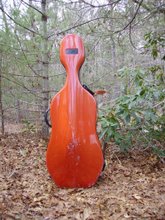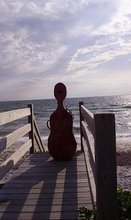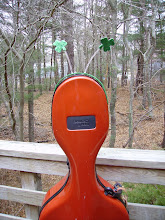August 12, 2007
Sunday was the first full day of Scottish fiddle camp. Saturday was spent arriving here, by car and by boat, hauling luggage and instruments, computers and electric fans (for the anticipated heat wave), meeting people, touring the facilities, eating dinner, and sessions. There are 85 people here, and most of them filled the hall Saturday night, playing Scottish tune after Scottish tune. I am so impressed by the high level of musicianship here and most people’s long-term interest and involvement with Scottish music. I am not here because of a long-term love of Scottish music, but because I love the way Abby Newton plays the cello. Since she plays Scottish fiddle and Scottish Baroque music, so I would have to say I am also a fan of Scottish music.
I was one of four cellists playing on Saturday night. I knew one tune (Mairi’s Wedding, an easy piece for both fiddle and cello), but most of the time, I improvised backup, watching the other cellists and listening to the piano.
People are incredibly nice,friendly, helpful, and easy to talk to. I forgot my USB cable, which I need to transfer recordings from my minidisc player to my computer, the camp director directed me to someone who might have such a cable with him. Turns out it was one of the other cellists, the one for whom I brought a rental cello to the camp. That worked out well! [Note: Today, I found my own USB cable—I had carefully stored it in a drawer. I’ve been just a little disorganized, but in an organized way.]
The first class I attended was a beginning fiddle class, playing cello along with one of the other cellists, to get more practice in learning by ear. This was good for me, and the tune was easy enough so that I got most of the notes readily. Shifting was required and high G# fingering required some thought, but we were playing slowly and the fingerings were not difficult. However, to bring this tune up to speed and add the accents and improve the distinctive rhythms that make it such a lively march will take it a little longer.
I just stayed in the fiddle room for the next class, in which I played fiddle, which was called Fiddling for the Very Beginner. A little boring in the beginning, but it turned out to be an excellent review of fiddle posture and bow hold, and the teacher gave me some useful pointers and helpful advice.
After lunch, there were two back-to-back classes with Abby Newton. Abby is wonderful, a caring teacher and helpful in my quest to learn to play by ear. All tunes at this camp are taught by ear, but varying degrees of help are given, depending on the students’ needs. The other three cellists have much more experience with Scottish music than I do, and they can play by ear better than I can. Some of them were familiar with the tune we learned, “Kinrara,” which is on Abby’s Castles, Kirks, and Caves CD. (Listen to this CD if you are at all interested in folk cello music!) So, I got a little more help than the others needed.
Abby likes to use open strings. A fine quality in a cellist. Apparently open strings are just fine in fiddling, though frowned upon in classical music. We learned the tune in the first session and learned two accompaniment styles to use it in the second session. When I say “learned,” I mean some people learned the whole tune. I learned most of it, in parts, but holding the whole thing together in my head was difficult.
After class, with the help of my recording and, yes, the sheet music, I am now able to play the piece. Some people say it is easier to learn by ear than from sheet music. I would have to agree, especially when you are in a class and the teacher is giving you helpful advice, such as “this is a scale part,” “determine the highest note and the lowest not in a phrase,” Note the fingering here carefully (2 on high F, followed by 2 on D), “Bowing here is up-up.” You can get the articulations, dynamics, and nuances better than you can get from the sheet music. For me, learning by ear from a CD or in a session is a little more difficult without those teacher prompts.
Abby says that when she learns a piece, she records herself playing it from sheet music and then learns from the recording, not the sheet music. Of course, I think she means learning as in memorizing, not learning as in figuring it out. But it is an interesting approach.
The concert tonight was outstanding. Gorgeous Scottish fiddle music! Anne Hooper, my beginning fiddle teacher, played, as did another fiddler, both with piano accompaniment. The piano accompaniment really added to the fiddling. I noticed this Saturday night in the jam session, and tried to stay with the piano in my accompaniment attempts.
Accommodations are fine. It’s like a tiny college campus, with several small red brick dormitory buildings, a few classroom and meeting buildings, and ocean views. The island is also used for Outward Bound, but I think the Outward Bound kids are roughing it elsewhere on the island. The weather has been perfect. Sunny, cool and comfortable. But all classes today were inside!
Monday, August 13, 2007
Beginning Fiddle Class was a review of the March we learned yesterday, plus the introduction of a new tune, a slow air, “Lovely Stornaway,” like the March, in the key of A. The March will be played by all when we go to welcome the visitors on Visitors’ Day, Tuesday. Cellists don’t have to march. I may play the March on my fiddle, if I have time to transfer my imperfect knowledge of the tune to fiddle. I like this beginning class because it goes slow enough for me to learn the tune, yet the teacher introduces embellishments and articulations that make the tunes sound good. And when I say “learn,” I mean learning in class. Forgetting it afterward is pretty common, unless you work on it, and even when you do.
Though I spent at least an hour working on “Kinrara” yesterday, it completely escaped me in class today. We reviewed that tune and learned a new one, “Willies Auld Trewes.” Both are in d minor, and both are beautiful tunes on the cello. Abby says she is teaching tunes that are fun to play and sound good on the cello, rather than just what the fiddles are playing. Makes sense to me. I continue to be the least able to pick up tunes by ear in cello class, but it’s ok. Eventually I will get this.
She is also teaching rhythmic drone accompaniment, as well as more chord-like accompaniment and countermelodies.
Today I worked on the March and the Air from fiddle class. Abby is performing tonight, and after that is a dance, but I might come back after the concert and practice the cello pieces. I should probably drop the fiddle class and concentrate on the cello tunes, but the learning by ear is more my speed in the fiddle class. We’ll see.
You can’t escape the “real world” here at fiddle camp. The theme of our big party on Wednesday night is Harry Potter.












3 comments:
Fantastic! What a great learning experience this must be for you. I really enjoyed reading what you wrote about playing by ear.
What? ... no marching cellists? But Woody Allen made it look so easy.
LOL on the Harry Potter theme. (see my latest post)
Hmmm. Playing along from memory using one's own recording from sheet music. I'll have to try that!
When I was at Maine Fiddle Camp with Rushad E. we marched and played at the same time, holding our cellos and playing "Camptown Races" in 4th position so you could sort of hold the cello with part of your left hand and your right arm!
I guess the school the Harry Potterites attend is in Scotland, so it makes sense on some level!
Two more new tunes today! Lots of concerts and incredible music and musicians.
It's hard to find time to write it all up, especially sitting out here in the dark at the wireless hotspot.
Nice to hear from you both!
Post a Comment